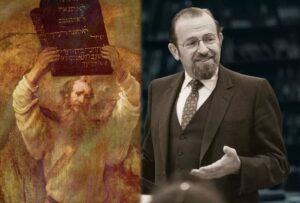How I Love Your Torah

 In Torah Beloved: Reflections on the Love of Torah and the Celebration of the Holiday of Matan Torah (OU Press), a compilation of Rabbi Dr. Norman Lamm’s classic, masterful sermons, one encounters R. Lamm exhorting the parishioners in his pews on the centrality of Torah and the crucial need to set aside serious time toward its study. Heshie Billet & Rookie Billet find the book useful in identifying the mantra of R. Lamm’s speeches, sermons, and other writings: Torah knowledge is essential for sophisticated Torah observance. Each of the sermons in this volume, designed to focus our thinking for the upcoming Shavuot holiday, focuses on the role of Torah study in the life of every Jew. Each sermon poses a dilemma, often grounded in the historical context of the moment, that is resolved with an original idea or creative reading arrived at through R. Lamm’s unique method of bringing classical sources into conversation with secular wisdom. “Hiddush,” the type of innovative insight served up in this book, was central to R. Lamm’s method and the relationship to Torah that he advocated. We once heard him expound upon the importance of hiddush:
In Torah Beloved: Reflections on the Love of Torah and the Celebration of the Holiday of Matan Torah (OU Press), a compilation of Rabbi Dr. Norman Lamm’s classic, masterful sermons, one encounters R. Lamm exhorting the parishioners in his pews on the centrality of Torah and the crucial need to set aside serious time toward its study. Heshie Billet & Rookie Billet find the book useful in identifying the mantra of R. Lamm’s speeches, sermons, and other writings: Torah knowledge is essential for sophisticated Torah observance. Each of the sermons in this volume, designed to focus our thinking for the upcoming Shavuot holiday, focuses on the role of Torah study in the life of every Jew. Each sermon poses a dilemma, often grounded in the historical context of the moment, that is resolved with an original idea or creative reading arrived at through R. Lamm’s unique method of bringing classical sources into conversation with secular wisdom. “Hiddush,” the type of innovative insight served up in this book, was central to R. Lamm’s method and the relationship to Torah that he advocated. We once heard him expound upon the importance of hiddush:
Happy the man who has not walked in the wicked’s counsel, nor in the way of offenders has stood, nor in the session of scoffers has sat. But the Lord’s teaching is his desire, and in His teaching he meditates day and night (Psalms 1:1–2). And in His teaching he meditates – In the beginning, it is called the Lord’s teaching, and after he has toiled to master it, he acquires it as his own Torah (Rashi).
R. Lamm asked, by what means does one acquire ownership over the Torah? Avot describes the 48 paths through which Torah is acquired (6:6). R. Lamm was intrigued by the meaning of “kinyan” Torah, the means of acquiring God’s word as one’s own. In the world of halakhic acquisition (kinyan), items can be purchased with money, a deed of sale, or by hazaka, an act of ownership such as putting a lock on a door, erecting a fence, or otherwise improving a property. If we are to speak of kinyan with respect to Torah knowledge, R. Lamm noted that while transfer of cash or deeds of sale could not possibly “purchase” knowledge of Torah, hiddush in Torah study serves as a form of hazaka. In particular, creating a new insight was, for him, the equivalent of making a physical improvement to a piece of property. Reading Torah with creativity and originality is the exercise of acquiring Torah.
In advance of celebrating Matan Torah, and R. Lamm’s 4th Yahrzeit (8 Sivan), read Heshie & Rookie Billet’s exploration of these themes in his writing (from TRADITION’s “Rabbi Norman Lamm Memorial Volume”).
